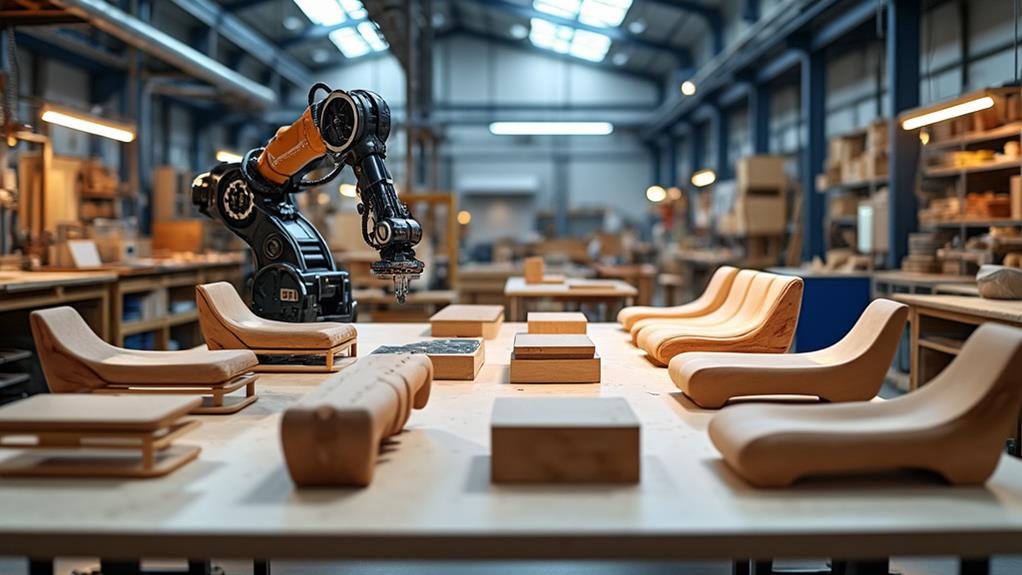Revolutionizing furniture manufacturing through innovation involves leveraging technologies like 3D printing and automation, which enhance efficiency and design flexibility. 3D printing allows for precise customization and reduces material waste, while automation guarantees consistent quality through robotics and real-time data integration. Sustainable material innovations focus on reducing the carbon footprint by using bio-based composites and renewable resources. AI-driven customization enhances customer satisfaction with personalized designs and minimizes surplus stock through demand alignment. Augmented reality further improves consumer experience by allowing furniture visualization in real spaces, easing decision-making. As we explore these advancements, we see a future shaped by technological and sustainable transformation.
Advances in 3D Printing
In today's rapidly evolving furniture industry, 3D printing frequently emerges as a transformative force redefining how we approach design and production. This technology allows us to craft intricate furniture parts with precise customization, reducing material waste and enhancing efficiency.
By streamlining supply chain operations, we improve overall workflow and facilitate quick prototyping, enabling swift design alterations based on customer demands. Additionally, 3D printing promotes the use of eco-friendly materials, greatly lowering carbon emissions during production.
As we incorporate this technology, we find it not only reshapes our manufacturing processes but also encourages sustainable practices. The ability to innovate swiftly and responsibly positions us at the forefront of a more efficient and environmentally conscious furniture industry.
Automation in Production
As we embrace 3D printing's transformative impact on our manufacturing processes, automation emerges alongside as a key driver of efficiency and quality in furniture production.
Automated assembly lines, powered by advanced robotics and computer systems, streamline various production stages. This integration guarantees consistent quality, with real-time data enhancing supply chain management and aligning production with demand.
Automation also facilitates complex design methods that were previously impractical for mass production. Sensors and visual inspection systems provide quality assurance, maintaining high standards across all products.
Sustainable Material Innovations
We've initiated a journey to revolutionize furniture production with sustainable material innovations. This shift focuses on utilizing materials that greatly reduce our carbon footprint.
By developing bio-based composites, we mimic wood's appearance while enhancing carbon efficiency. These composites, crafted from renewable resources, help decrease reliance on traditional wood, contributing to environmental preservation.
Incorporating fast-growing plant materials as alternatives provides a sustainable solution, ensuring resource renewal. Additionally, innovative methods optimize material usage, effectively minimizing waste during production.
This commitment to sustainability sets a foundation for an environmentally responsible industry, aligning with global efforts to combat climate change. Our approach not only supports ecological balance but also positions us as leaders in sustainable furniture manufacturing, fostering a greener future.
AI-Driven Customization
Our journey into AI-driven customization is transforming how we tailor furniture to individual tastes and preferences. We utilize advanced algorithms that act like personal interior designers, interpreting customer styles to create personalized furniture designs. This technology not only enhances customer satisfaction but also streamlines our supply chain.
By aligning production with specific demands, we reduce surplus stock and minimize carbon emissions. Our platforms offer intuitive design experiences, allowing customers to participate actively in the design process. This democratization of design makes custom furniture more accessible and cost-effective for a broader market.
As AI continues to evolve, we expect even more refined personalization capabilities, setting new industry standards for customization and consumer engagement in furniture manufacturing.
Augmented Reality Applications
Augmented reality, or AR technology, is transforming the way we shop for furniture by allowing us to visualize products in our own spaces before making a purchase. This capability greatly reduces uncertainty, enhancing customer satisfaction and minimizing product returns.
By placing digital furniture models into real-world environments through our smartphones or tablets, we can make informed decisions, ensuring that each piece fits seamlessly within our existing decor. AR applications streamline the purchasing process by providing a practical view, reducing guesswork, and increasing buyer confidence.
As AR technology continuously updates, we witness improved consumer interaction and engagement. This not only benefits consumers but also bolsters supply chain efficiency by aligning production with actual demand, ultimately leading to more resilient and effective operations.
Future of Manufacturing
As we look to the future of manufacturing, embracing technological advancements and sustainable practices will be vital for shaping a more efficient and environmentally friendly industry.
We must focus on integrating cutting-edge innovations like 3D printing and automated assembly lines, which enhance production efficiency and reduce waste. These technologies allow us to create intricate designs and guarantee consistent quality, aligning manufacturing processes with modern demands.
Sustainable materials, such as bio-based composites, play an important role in minimizing the carbon footprint of furniture production. By utilizing fast-growing plant materials and optimizing resource use, we pave the way for an eco-conscious approach.
Together, these advancements promise a future where technology and sustainable practices revolutionize the way we manufacture furniture.
Emerging Market Trends
The future of manufacturing is bright with technological and sustainable innovations, and these advancements are reshaping the landscape of furniture market trends.
We're witnessing a significant increase in the adoption of augmented reality (AR) technology, enhancing online shopping experiences. AR allows consumers to visualize furniture in their spaces, boosting confidence in purchasing decisions and reducing returns. This trend aligns with the growing preference for online shopping, as more consumers seek convenience and customization.
Additionally, innovative marketing strategies incorporating AR features are gaining traction, highlighting the competitive edge of tech-savvy retailers. Industry reports indicate a positive correlation between AR utilization and sales growth, pushing the market towards a more interactive and immersive consumer experience.
This shift impacts how we perceive and engage with furniture.
Enhancing Supply Chain Resilience
Boosting supply chain resilience is fundamental in today's fast-paced furniture industry. By integrating technology like augmented reality (AR), we enhance inventory management and predict demand more accurately. This reduces operational costs as fewer returns streamline logistics.
AR facilitates better visualization, helping customers make informed decisions, which, in turn, strengthens our supply chain. Furthermore, collaboration between manufacturers and retailers is imperative. Real-time data sharing aligns production with consumer needs, guaranteeing prompt adaptation to market changes.
Adopting automation in production processes also plays an essential role. Real-time monitoring and advanced robotics guarantee consistent quality, reducing waste and inefficiencies.
As we prepare for future challenges, technology integration provides the flexibility needed to withstand disruptions, guaranteeing a robust and resilient supply chain.


